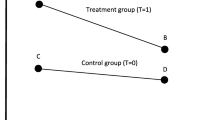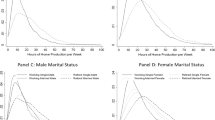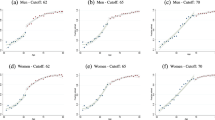Abstract
In this paper, we investigate the way consumption changes around retirement in Italy. Using micro data covering the 1985–1996 period, we document the existence of a one-off drop in consumption at retirement of the household head, as in the UK and the US, but (at 5.44%) smaller in size, and show that consumption of work-related goods falls around retirement and home production of food and other goods increases.
Similar content being viewed by others
References
Aguiar M, Hurst E (2005) Consumption versus expenditure. J Polit Econ 113(5): 919–948
Aguiar M, Hurst E (2007) Lifecycle prices and production. Am Econ Rev 97(5): 1533–1559
Attanasio OP (2000) Consumption demand. In: Taylor J, Woodford M (eds) Handbook of macroeconomics. North Holland, New York
Attanasio OP, Banks J, Meghir C, Weber G (1999) Humps and bumps in lifetime consumption. J Bus Econ Stat 17(1): 22–35
Attanasio OP, Brugiavini A (2003) Social security and households’ saving. Quart J Econ 118(3): 1075–1119
Banks J, Blundell R, Tanner S (1998) Is there a retirement-savings puzzle. Am Econ Rev 88(4): 769–788
Battistin E, Miniaci R, Weber G (2003) What do we learn from recall consumption data. J Hum Resour 38(2): 354–385
Battistin E, Brugiavini A, Rettore E, Weber G (2009) The retirement consumption puzzle: evidence from a regression discontinuity approach. Am Econ Rev (forthcoming)
Bernheim BD, Skinner J, Weinberg S (2001) What accounts for the variation in retirement wealth among U.S. households?. Am Econ Rev 91(4): 832–857
Blau DM (2008) Retirement and consumption in a life cycle model. J Labor Econ 26(1): 35–71
Blundell RW (1986) Consumer behaviour: theory and empirical evidence. Econ J 98(1): 16–65
Browning M, Lusardi AM (1996) Household saving: micro theories and micro facts. J Econ Lit 34(4): 1797–1855
Brugiavini A (1999) Social security and retirement in Italy. In: Gruber J, Wise D (eds) Social security and retirement around the world. The University of Chicago Press, Chicago
Deaton A (1992) Understanding consumption. Oxford University Press, Oxford
De Nardi M, French E, Jones JB (2006). Differential mortality, uncertain medical expenses, and the saving of elderly singles. NBER Working Papers 12554
Grant C, Miniaci R, Weber G (2002) Changes in consumption behaviour: Italy in the early 1990s. Giornale degli Economisti 60(1): 61–101
Hurd M, Rohwedder S (2008) The retirement consumption puzzle: actual spending change in panel data. NBER WP 13929
Hurst E (2008) The retirement of a consumption puzzle. NBER WP 13789
Inquiry Commission on Poverty (1997) Poverty in Italy 1980–95, Presidency of the Council of Ministers. Department of Information and Publishing, Rome
Jappelli T, Pistaferri L (2000) The dynamics of household wealth accumulation in Italy. Fiscal Stud 21(2): 269–295
Jappelli T, Pistaferri L, Weber G (2007) Health care quality, economic inequality, and precautionary saving. Health Econ 16(4): 327–346
Kolodziejczyk C (2006) Retirement and fixed costs to work: an empirical analysis. CAM Working Paper, 2006–09
Miniaci R, Weber G (1999) The Italian recession of 1993: aggregate implications of microeconomic evidence. Rev Econ Stat 81(2): 237–249
Miniaci R, Monfardini C, Weber G (2002) Changing consumption patterns. In: Siebert H (eds) Economic policy for aging societies. Springer, Berlin, pp 53–76
Monfardini C, Miniaci R, Weber G (2001) La spesa in beni non durevoli nell’Indagine sui consumi delle famiglie (Non-durable Expenditure in the Italian Survey on Family Budgets). University of Padua, mimeo
Palumbo MG (1999) Uncertain medical expenses and precautionary saving near the end of the life cycle. Rev Econ Stud 66(2): 395–421
Shorrocks A (1975) The age–wealth relationship: a cross-section and cohort analysis. Rev Econ Stat 57: 155–163
Author information
Authors and Affiliations
Corresponding author
Rights and permissions
About this article
Cite this article
Miniaci, R., Monfardini, C. & Weber, G. How does consumption change upon retirement?. Empir Econ 38, 257–280 (2010). https://doi.org/10.1007/s00181-009-0265-y
Received:
Accepted:
Published:
Issue Date:
DOI: https://doi.org/10.1007/s00181-009-0265-y




